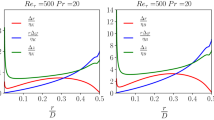Abstract
While methods for assessing the uncertainty of Reynolds–Averaged–Navier–Stokes (RANS) simulations have been well established in the past, the verification of Large Eddy Simulations (LES) is more difficult. One reason is that the numerical discretization error as well as the subgrid scale model contribution depend on the grid resolution and that both terms interact. In the present paper the accuracy of single-grid estimators to assess the amount of the unresolved turbulent kinetic energy is studied first. In the second part of the paper the sensitivity of the simulation results on the modeling error as well as the numerical error will be investigated in the context of LES with implicit filtering. This will be achieved by performing a systematic grid and model variation. The analysis is applied to an isothermal, turbulent, plane jet and a turbulent channel flow.
Similar content being viewed by others
References
Roache, P., Verification and Validation in Computational Science and Engineering. Hermosa Publishers, Albuquerque (1998).
Stern, F., Wilson, R., Colemana, H. and Paterson, E., Comprehensive approach to verification and validation of CFD simulations. ASME J. Fluids Eng. 123 (2001) 793–802.
Celik, I., Cehreli, Z. and Yavuz, I., Index of resolution quality for large eddy simulations. ASME J. Fluids Eng. (in press).
Geurts, B. and Fröhlich, J., A framework for predicting accuracy limitations in large eddy simulations. Phys. Fluids 14(6) (2002) L41–L44.
Chow, F. and Moin, P., A further study of numerical errors in large-eddy simulations. J. Computat. Phys. 184 (2003) 366–380.
Kravchenko, A. and Moin, P., On the effect of numerical errors in large eddy simulation of turbulent flows. J. Computat. Phys. 131 (1997) 310–322.
Meyers, J., Geurts, B. and Baelmans, M., Database analysis of errors in large-eddy simulation. Phys. Fluids 15(9) (2003) 2740–2755.
Hoffman, J., On duality based a posteriori error estimation in various norms and linear functionals for LES. SIAM J. Sci. Comput (in press).
Layton, W. and Lewandowski, R., Consistency and Feasibility of Approximate Deconvolution Models of Turbulence. Technical Report TR-MATH-04-07, University of Pittsburgh, Department of Mathematics (2004).
Lund, T., On the Use of Discrete Filters for Large Eddy Simulation. Technical report, Center for Turbulence Research, Annual research Briefs (1997).
Sagaut, P., Large Eddy Simulation for Incompressible Flows. Springer, New York (1998).
Rogallo, R. and Moin, P., Numerical simulations of turbulent flow. Annu. Rev. Fluid Mech. 16 (1984) 99–137.
Schumann, U., Subsgrid scale model for finite difference simulations of turbulent flow in plane channels and annuli. J. Comp. Phys. 18 (1975).
Breuer, M., Direkte Numerische Simulation und Large-Eddy Simulation turbulenter Strömungen auf Hochleistungsrechnern. SHAKER Verlag (2001).
Gullbrand, J., Grid-independent Large-Eddy Simulation in Turbulent Channel Flow Using Three-dimensional Explicit Filtering. Technical report, Center for Turbulence Research, Annual research Briefs (2003).
Speziale, C., Turbulence modeling for time-dependent RANS and VLES: A review. AIAA J. 36(2) (1998) 173–184.
Schuhmann, U. and Sweet, R., A direct method for the solution of Poissons Equation with Neumann boundary conditions on a staggered grid of arbitrary size. J. Comp. Phys. 20 (1976) 171–182.
Klein, M., Sadiki, A. and Janicka, J., Investigation of the influence of the Reynolds number on a plane jet using direct numerical simulation. Int. J. Heat Fluid Flow 24/6 (2003) 785–794.
Klein, M., Sadiki, A. and Janicka, J., A digital filter based generation of inflow data for spatially developing direct numerical or large eddy simulations. J. Comp. Phys. 186 (2003) 652–665.
Hinze, J., Turbulence. McGraw-Hill, New York (1959).
Moser, R.D., Kim, J. and Mansour, N., Direct numerical simulation of turbulent channel flow up to Re τ = 590. Phys. Fluids 11(4) (1999) 943–945.
Kim, J., Moin, P. and Moser, R., Turbulence statistics in fully developed channel flow at low Reynolds number. J. Fluid Mech. 177 (1987) 133–166.
Pope, S., Ten questions concerning the large-eddy-simulation of turbulent flows. New J. Phys. 6(35) (2004).
Lilly, D., The representation of small scale turbulence in mumerical simulation experiments. In: Proceedings of the IBM Scientific Computing Symposium on Environmental Sciences (1967) pp. 195–210.
Ribault, C.L., Sarkar, S. and Stanley, S., Large eddy simulation of a plane jet. Phys. Fluids 11 (1999) 3069–3083.
Author information
Authors and Affiliations
Corresponding author
Rights and permissions
About this article
Cite this article
Klein, M. An Attempt to Assess the Quality of Large Eddy Simulations in the Context of Implicit Filtering. Flow Turbulence Combust 75, 131–147 (2005). https://doi.org/10.1007/s10494-005-8581-6
Received:
Accepted:
Issue Date:
DOI: https://doi.org/10.1007/s10494-005-8581-6




